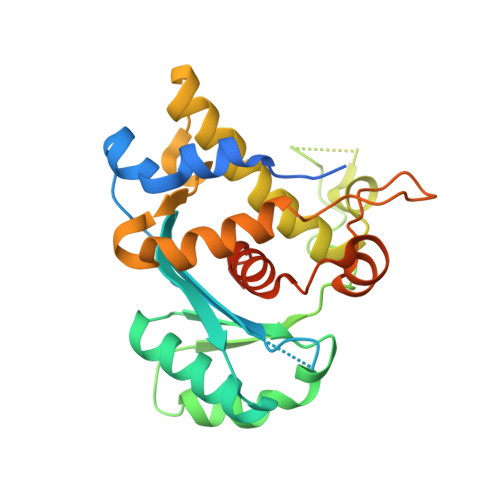Two distinct modes of metal ion binding in the nuclease active site of a viral DNA-packaging terminase: insight into the two-metal-ion catalytic mechanism.
Zhao, H., Lin, Z., Lynn, A.Y., Varnado, B., Beutler, J.A., Murelli, R.P., Le Grice, S.F., Tang, L.(2015) Nucleic Acids Res 43: 11003-11016
- PubMed: 26450964
- DOI: https://doi.org/10.1093/nar/gkv1018
- Primary Citation of Related Structures:
5C10, 5C12, 5C15, 5C2D, 5C2F - PubMed Abstract:
Many dsDNA viruses encode DNA-packaging terminases, each containing a nuclease domain that resolves concatemeric DNA into genome-length units. Terminase nucleases resemble the RNase H-superfamily nucleotidyltransferases in folds, and share a two-metal-ion catalytic mechanism. Here we show that residue K428 of a bacteriophage terminase gp2 nuclease domain mediates binding of the metal cofactor Mg(2+). A K428A mutation allows visualization, at high resolution, of a metal ion binding mode with a coupled-octahedral configuration at the active site, exhibiting an unusually short metal-metal distance of 2.42 Å. Such proximity of the two metal ions may play an essential role in catalysis by generating a highly positive electrostatic niche to enable formation of the negatively charged pentacovalent phosphate transition state, and provides the structural basis for distinguishing Mg(2+) from Ca(2+). Using a metal ion chelator β-thujaplicinol as a molecular probe, we observed a second mode of metal ion binding at the active site, mimicking the DNA binding state. Arrangement of the active site residues differs drastically from those in RNase H-like nucleases, suggesting a drifting of the active site configuration during evolution. The two distinct metal ion binding modes unveiled mechanistic details of the two-metal-ion catalysis at atomic resolution.
- Department of Molecular Biosciences, University of Kansas, 1200 Sunnyside Avenue, Lawrence, KS 66045, USA.
Organizational Affiliation:

















